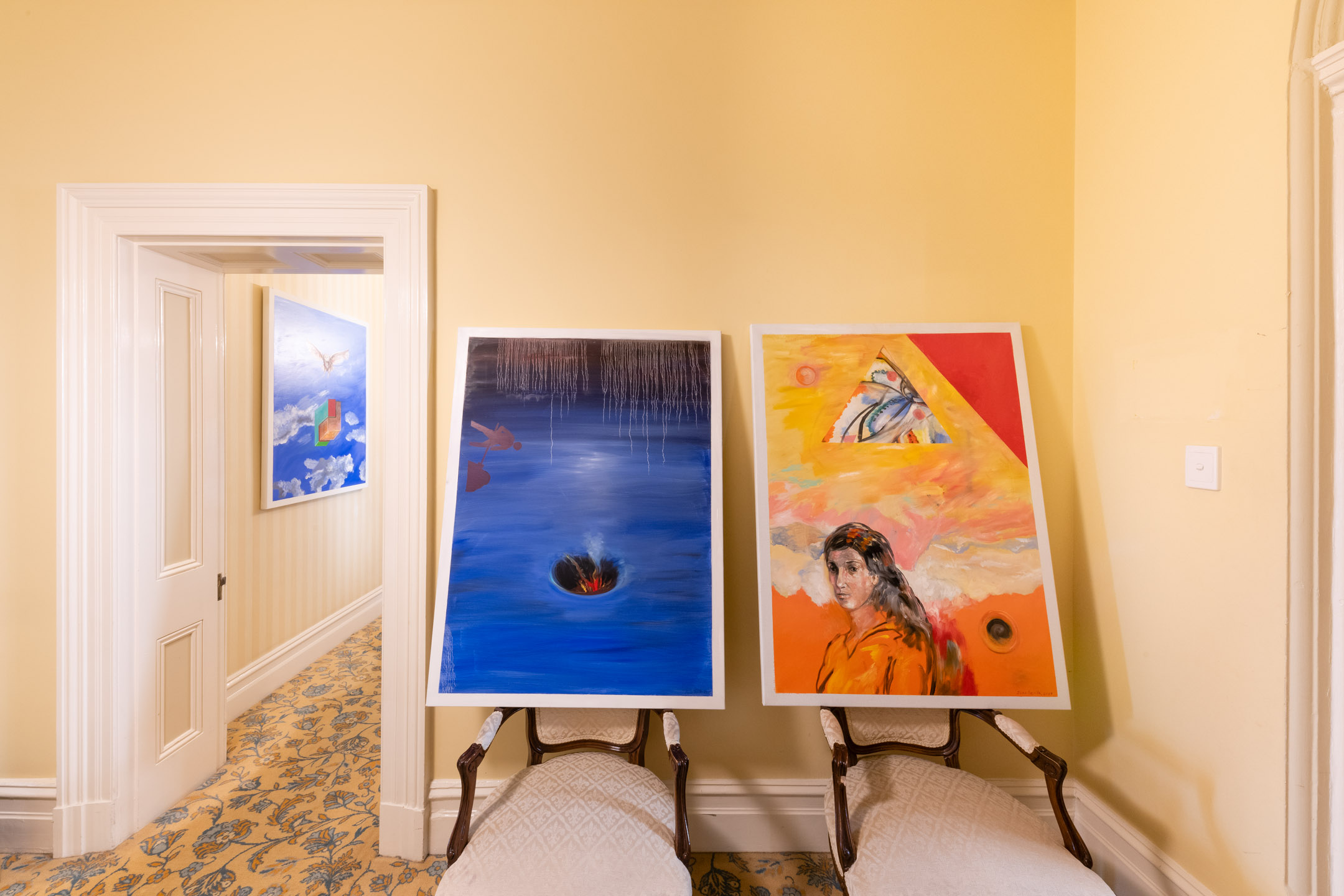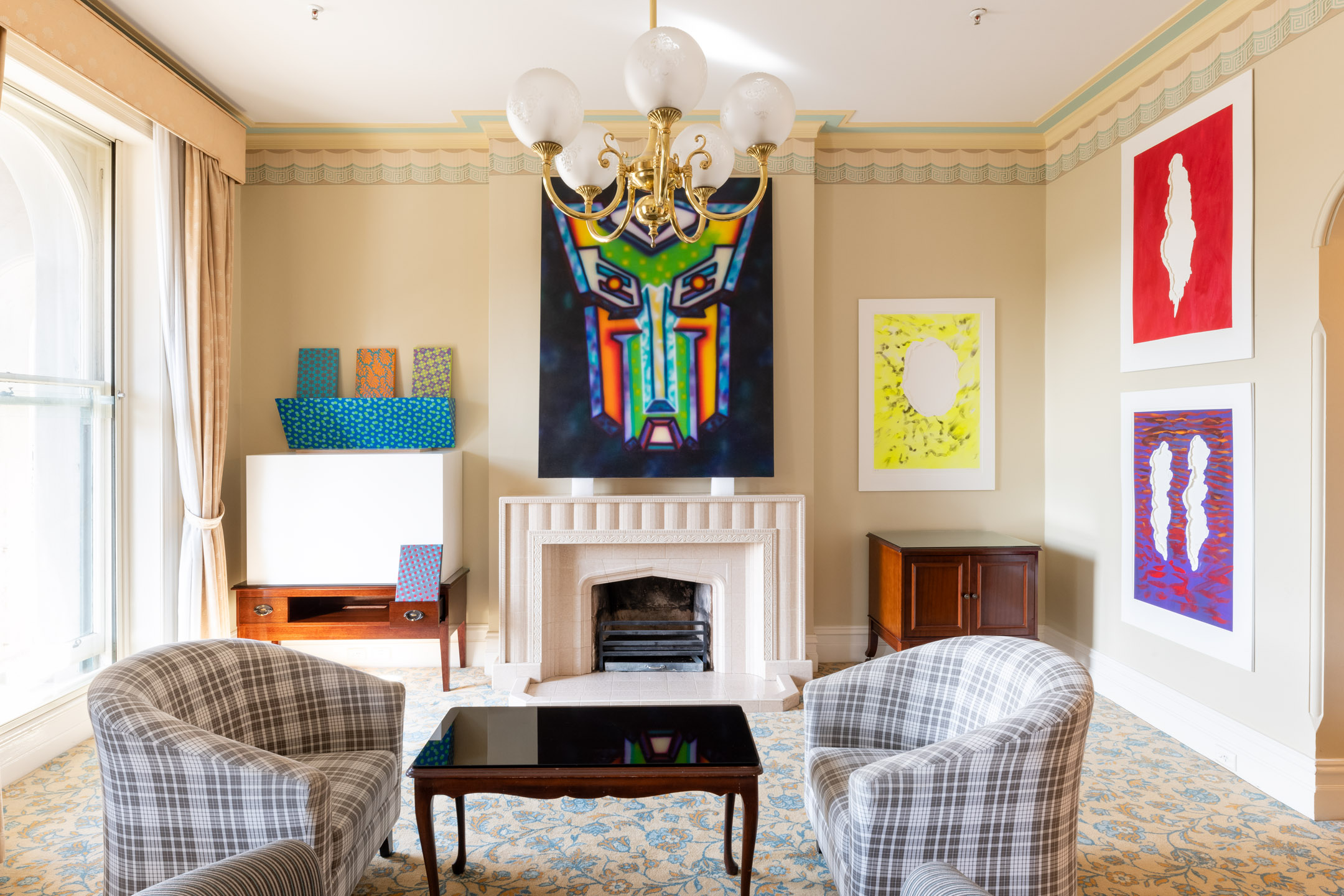Spring1883 Art Fair
Rex Butler
It’s poignant looking through the beautiful hardback catalogue of the Museum of Contemporary Art’s 2006 Juan Davila retrospective.
There on page sixty-one is a big colour photo of his dealer Kalli Rolfe’s space at the 2000 Melbourne Art Fair in the vast cathedral-like space of the old Exhibition Building. It’s Davila’s show Love’s Progress, featuring two huge lushly painted McCubbin piss-takes, Lost (1999) and Bush Burial (2000).
Then across pages 204 and 205 there for a 2003 show at 45 Downstairs, also put on by his dealer, is the spectacular installation Panorama of Santiago, Chile (1973–2003), an enormous circular frieze like Monet’s waterlilies depicting a group of people looking off a bridge that crosses a river, held above a series of brilliant conceptual riffs on Courbet’s infamous close-up of his Irish lover Joanna Heffernan’s genitals, The Origin of the World (1866).

Now some twenty years have passed, and we have twenty acrylics on paper, 105 by 75 cms, in a small hotel room in the Windsor Hotel on Spring Street as part of Spring1883.
We are all older, tireder, less hopeful but also less irreverent and sceptical. The dashing young Davila photographed with three of his paintings in Six Approximations to Surrealism in Chile in Santiago in 1975 is no more. Neither even is the more respectable middle-aged artist-businessman in suit and tie in the frontispiece to the catalogue. Now at the opening of Spring Davila stands quietly in the room with thinning white hair and thick black glasses, slightly hard of hearing and having recently lost his beloved partner of fifty years.
It is the moment of Davila’s late style, his Shakespearean late comedies after the tragedies and earlier actually funny comedies. His Strauss’s Metamorphosen and Four Last Songs. His Beckett’s three-page short stories and one-person plays.
Great critics have tried to capture something of this late style. The Marxist Theodor Adorno argued that it was an expression of the violence of “late” capitalism, which should discredit any belief that capitalism is simply an agent for modernisation. The post-colonial theorist Edward Said proposed that it might represent not a simple resignation or reconciliation, but rather intransigence, difficulty, and contradiction.
When might we say Davila’s late style started? It is tempting to suggest as long ago as 2010 with his extraordinary exhibition The Moral Meaning of Wilderness, in which the straight lines, cartoon-like appropriations and in-your-face gay men doing things to each other were replaced by delicate wavering brushstrokes, sun-lit outdoors settings and women either posed self-assuredly before us or lying naked on riverbanks.

But I maybe want to say it started in 2012 with a beautiful mournful portrait of his good friend, the Melbourne photographer Polixeni Papapetrou, at that point seriously ill, her jet-black Greek hair and eyes and her jet-black dress all done in the same seamless jet-black paint. (For some reason I’m always reminded when I look at it of Manet’s wonderful Self-Portrait with Palette of 1879, in which those dabs of paint at the end of his paintbrushes are the dabs of paint that paint the paintbrushes and the thick swabs of paint on his palette are those same thick swabs of paint.)
Now at Spring—how ironic the title—the work is even lighter and more attenuated. It’s almost as though Davila doesn’t want to be there making it. But also at the end he goes back to first principles, taking up those things that guide us all, the two motifs that run through all of his practice.
In Untitled (2023), a naked woman holds a large Moebius-like three-dimensional circle above her head. It could almost be that suspended frieze-like canvas of Panorama of Santiago. We see something like this again in Fig 328 (2022), this time as a white cone of light cast upon a floor, and Untitled (2023) as a magnifying glass. It’s an annulus, and I think it is possible to say that as it is used in Davila’s work it is a figure of death.
Then there is a series of works in which strips are torn raggedly out of the centre of the paper, like Fig 307 (2021) and Fig 308 (2021), or even Fig 310 (2021) and Fig 314 (2021). It’s easy enough to suggest that it comes out of Davila’s long obsession with Courbet’s Origin of the World, although we also see something of it in the beautiful flickering flame he adds to Magritte’s The Empire of Light (1954) in his Untitled (1998). And I think it is fair to say that it represents life.

Altogether it reminds me of the extraordinary hang that greets you—or used to—as you enter the Musée d’Orsay in Paris. On one side of the door is L’origine du monde and on the other Courbet’s Funeral at Ornans (1849), in which the now hip and cosmopolitan Courbet goes back to his home town for the burial of his grandfather, whose grave separates him from what he looks at and marks the death of his old self. (And, yes, let’s call that black hole in the ground there an annulus.)
These slight works on paper are hardly there and are made by a man who is hardly still here. But more and more I am convinced that Davila is maybe the best—if not the most culturally important—Australian artist of the past forty years. And if any of this survives, he will live forever. But I don’t think it will, and I don’t think Davila does either. Everything is now as black as that dress that Papapetrou wears, but art is the beauty of this death.
For further images and details see kalli-rolfe-contemporary-art-juan-davila.pdf
Rex Butler teaches Art History in the Faculty of Art Design and Architecture at Monash University.


